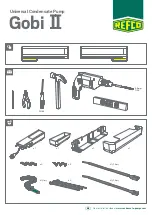
Refrigeration Maintenance
10-14
NOTE: If the low side will not pump down into a vacuum, the hot gas solenoid, or the receiver tank pressure check valve
may be stuck open. See the individual component tests for more information.
6. Continue pumping down the low side until it reaches a 25 in. Hg vacuum (-85 kPa), then turn the unit Off.
7. The low side pressure should remain below a 15 in. Hg vacuum (-51 kPa) for 2 minutes or more.
• If the low side pressure rises to 0 psig (0 kPa) and stops, there is probably a leak to the atmosphere. Check the low side for
leaks.
• If the low side pressure rises above 0 psig (0 kPa) and continues to rise (until it eventually equalizes with the high side
pressure), there is probably a leak from the high side to the low side through one (or more) of the following components:
hot gas solenoid, receiver tank pressure check valve, or the discharge valve plates in the compressor. Check the
temperatures of the refrigeration lines on each side of these components by hand. There is often a temperature difference
between the two sides of a leaking component. See the individual component tests for more information.
8. Back seat the receiver tank outlet valve. Perform a “Refrigerant Gauge Removal” procedure.
LOW SIDE PUMP DOWN RECIPROCATING COMPRESSOR
Operate the unit in cool for 10 minutes before performing the low side pump down.
1. Attach a gauge manifold to the suction service valve and the discharge service valve.
2. Operate the unit in high speed cool.
3. Front seat the receiver tank outlet valve and allow the low side to pump down to a 15 in. Hg vacuum (-51 kPa).
4. Turn the unit Off.
5. Prepare to perform service on the low side by raising the low side pressure through the gauge manifold to 1 to 2 psig (7 to 14
kPa).
6. Back seat the receiver tank outlet valve. Perform a “Refrigerant Gauge Removal” procedure.
LOW SIDE PUMP DOWN SCROLL COMPRESSOR
CAUTION: Do not pull scroll compressor into a vacuum below 10 in. Hg vacuum (-34 kPa) to perform routine maintenance
procedures.
NOTE: Operate the unit in cool for 2 to 5 minutes before performing the low side pump down.
1. Attach a gauge manifold to the suction service valve and the discharge service port. Attach another low pressure gauge to the
suction access port located in the suction line near the accumulator inlet. Low loss fittings must be used on the hoses connected
to the discharge service port and the suction access port.
2. Operate the unit in low speed cool.
3. Front seat the receiver tank outlet valve and allow the low side to pump down to 0 to 5 in. Hg vacuum (0 to -17 kPa).
CAUTION: Do not run scroll compressor in a vacuum for more than 1 minute.
NOTE: To check certain components, front seat the suction service valve to isolate the low side while it is still in a vacuum.
See “Refrigeration System Checks” and the individual component tests for more information.
4. Turn the unit Off.
5. Prepare to perform service on the low side by raising the low side pressure through the gauge manifold to 1 to 2 psig (7 to 14
kPa).
6. Front seat the suction service valve to isolate the low side. The discharge check valve in the compressor is an imperfect seal
and will not keep the discharge pressure from leaking back through the compressor. Use the suction access port located near
the accumulator inlet to access the low side for leak testing and evacuation.
7. Back seat the suction service valve and then the receiver tank outlet valve. Perform a “Refrigerant Gauge Removal”
procedure.
R-404A/R-452A/R-134A
These units use R-404A/R-452A (R-134A - T-Dairy). This refrigerant is classified as a Hydro-fluorocarbon (HFC) because it
contains hydrogen fluorine and carbon. It does not contain chlorine.
Summary of Contents for T-1000R
Page 14: ...Safety Precautions 2 6 Warning Decals 2e24151g0 ...
Page 34: ...Maintenance Inspection Schedule 4 10 ...
Page 57: ...Unit Description 5 23 Purge Mode UT Series 1 3 4 5 2 ...
Page 67: ...Unit Description 5 33 Zone 1 Cool and Zone 2 Cool UT SPECTRUM Units ...
Page 69: ...Unit Description 5 35 Purge Mode UT SPECTRUM Units ...
Page 71: ...Unit Description 5 37 Zone 1 Cool and Zone 2 Heat UT SPECTRUM Units ...
Page 72: ...Unit Description 5 38 ...
Page 74: ...Diesel Electric Menu 6 28 Adjust Brightness 6 29 Time 6 30 ...
Page 120: ...Operating Instructions Standard HMI 7 18 ...
Page 152: ...Engine Maintenance 9 14 T Series Fuel and Oil System Components TK 376 ...
Page 154: ...Engine Maintenance 9 16 T Series Fuel and Oil System Components TK 270 ...
Page 156: ...Engine Maintenance 9 18 UT Series Fuel System Components AMA768 ...
Page 172: ...Engine Maintenance 9 34 T Series Engine Mounting Components for 2 Cylinder Engine ...
Page 184: ...Engine Maintenance 9 46 ...
Page 238: ...Refrigeration Maintenance 10 54 ...
Page 246: ...Clutch Maintenance 11 8 ...
Page 258: ...Structural Maintenance 12 12 ...
Page 264: ...Mechanical Diagnosis 13 6 ...
Page 265: ...14 Electric Standby Diagnosis ...
Page 268: ...Electric Standby Diagnosis 14 4 ...
Page 269: ...15 Refrigeration System Diagnosis ...
Page 272: ...Refrigeration System Diagnosis 15 4 ...
Page 280: ...Remote Evaporators 16 8 ...
















































